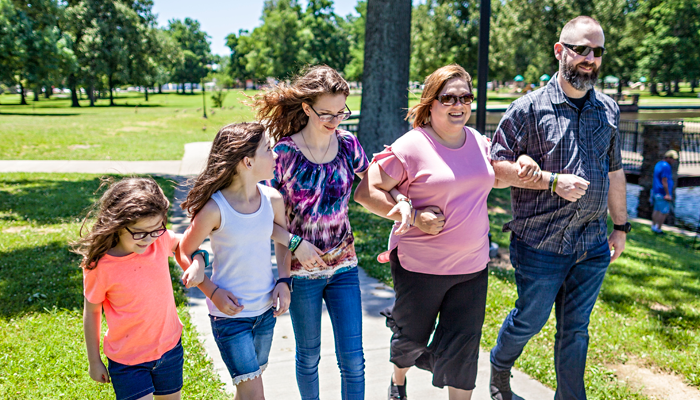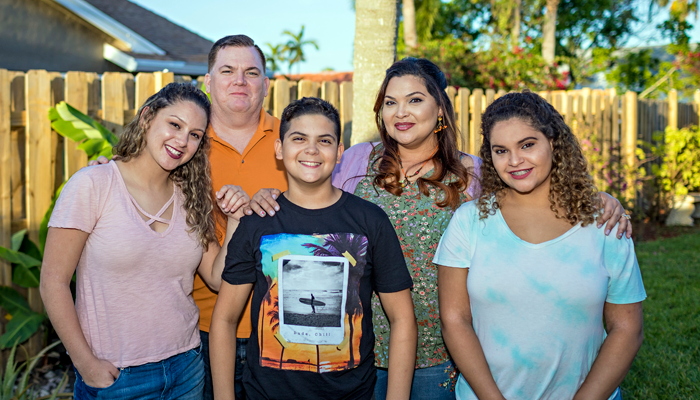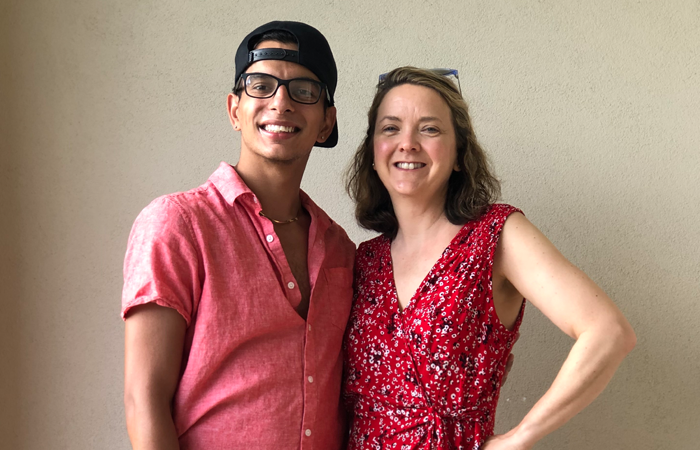(above, from left): Maci (adopted as a teen from foster care), Maci, Chris (dad), Christopher, Gigi (mom) and Carolyn, of Florida.
“Home is where one starts from.” These simple words are from a poem by T.S. Eliot. For most of us, home and family are a given and, at times, something we might take for granted. Home is not only where we start from, but also a place we revisit throughout our lives—for comfort in times of sadness, for celebration in times of joy, and for daily support and love. Unfortunately, home and family are much more elusive and complicated for the tens of thousands of children in foster care waiting to be adopted.
Today in the United States, more than 443,000 children are in some form of temporary out-of-home care or foster care, most often due to abuse or neglect they suffered in their biological family homes. For more than 123,000 of those children, the professionals charged with their care have determined that their biological family can never be safe enough for their return, and all parental rights and responsibilities have been severed. Permanently. That leaves these children in the custody of the state, waiting for an adoptive family and a home.
Although children of all ages are currently in foster care, nearly 45 percent of the children waiting to be adopted are ages eight or older. Older youth in care experience not only the typical identity exploration, independence cravings, and adult testing that all adolescents experience, but must also grapple with the profound grief and loss that has surrounded their lives—all without a permanent family.
Tragically, child welfare systems aren’t always looking for adoptive homes for older children and teens. Last year, more than 24,000 of these children had a case plan goal of emancipation, or long-term foster care, both of which consign a child to leaving the system without the security of a permanent family. Research shows that children who leave the foster care system without being adopted are at significantly higher risk of being homeless, undereducated, unemployed, substance abusers, parents at an early age, and/or involved in the criminal justice systems.
The Dave Thomas Foundation for Adoption challenges the systemic notion that these children are unadoptable. That notion is unacceptable to us.
When Dave Thomas, the founder of Wendy’s, created the Dave Thomas Foundation for Adoption in 1992, he insisted that we create a laser-like focus on serving children and youth most at risk of aging out of care without a family. As an adoptee, he understood the complexities of the systems. He often said, “These children are not someone else’s responsibility. They are our responsibility.”
For more than 25 years, the Foundation has successfully increased both the awareness of this cause and the need for qualified, well-supported foster and adoptive parents. Wendy’s Wonderful Kids, an evidence-based signature program of the Foundation, is working in all 50 states, D.C., and throughout Canada, for youth, like Maci, who have lingered in care for so long that they have given up hope for a family.
Adopted just 51 days before her 18th birthday, Maci had all but given up hope of having a loving family. Placed into foster care at age 15 after the death of her parents, Maci said she had come to terms with being alone. “I was scared. I was lost. I felt hopeless. It was awful.” But one of the more than 400 Foundation-funded adoption professionals worked with her and found a family. “Once I got into the family, my world started to change, my mindset started to change, my future started to change,” Maci says. [Read more of Maci’s story.]
When a rigorous evaluation of Wendy’s Wonderful Kids was released in 2011—revealing that children served by the program are up to three times more likely to be adopted—the Foundation began scaling this proven program across North America. To date, more than 8,000 children have been adopted through Wendy’s Wonderful Kids, and the average age of a child being served is 13.
It is true that older youths in the foster system have often experienced multiple placements, with the accompanying changes in schools, friends, and daily rules and routines, and that such instability can give rise to significant trust and attachment issues. But many other damaging misperceptions surround the children in foster care and the foster adoption process, unnecessarily giving many potential adoptive parents pause. Some common myths—and the underlying realities—about adopting teens and older children include:
Myth 1: Older youth are nearly adults. They don’t need to be adopted.
Reality: The complex adolescent and young adult years are critical to the formation of a happy and healthy adult life. Teens desperately need the stability, guidance, and love that only a permanent family can provide. Our need for family does not diminish with age.
Myth 2: Older youth in foster care are there because they are juvenile delinquents.
Reality: Youth are in foster care through no fault of their own. They have been removed from their families of origin due to abuse or neglect.
Myth 3: An older child just cannot blend into a new family.
Reality: It may take time for an older child to adjust, but the Patterson family says it best:
“We met Haylee in September 2016. We weren’t sure what we were getting into, but we knew the need for foster-to-adopt families was critical. We also knew that teenagers were being overlooked and that thousands of teens needed loving parents. We wanted to be that family for a teenager. When Haylee came to live with us, it was easy to see she was broken, lacked confidence, and couldn’t see all the beautiful things about her. It’s hard to blame her, she had been through a lot. As she once said, ‘no one wanted a child like [her].’ But now, we have a hard time remembering life without her. It’s like she’s always been here.” [Read more of Haylee’s story.]

Haylee (center; adopted as a teen), with her sisters Peyton and MacKenzie, and parents, Jacquelynn and Kevin, of Kentucky.
Myth 4: It is too expensive to adopt.
Reality: Foster care adoption is not expensive. It typically averages $0 to $1,500, and financial support is available to families who adopt from foster care. In addition, subsidies follow most of the children in foster care until they are 18 or 21 years old, many employers provide adoption benefits, federal and state tax credits are available, and assistance for college expenses is increasingly accessible.
Myth 5: The biological parents can try to have the child returned.
Reality: Once a child has been made legally free for adoption, birth parents cannot ‘reclaim’ the child or petition for his or her return. Foster care adoption is permanent. The adoptive parents may decide to maintain contact with the child’s extended biological family, based on what is best for the child, but that is a choice of the adoptive family.
Myth 6: Single individuals or older adults cannot adopt.
Reality: Unmarried individuals are legally able to adopt in all 50 states. Nearly 30 percent of the children adopted from foster care last year were adopted by single parents, and older adults are increasingly stepping forward to adopt.
Another thought that gives some parents considering older child adoption pause is the idea of “missing” so much of their child’s formative experiences. Says Sadie Marshall-Corley, who adopted 15-year-0ld Latrell:
“While Latrell was already a teenager when we met, his experiences had been so limited. It was heartbreaking at first, but we realized that it allowed us to experience a lot of the typical ‘firsts’ with him that are often missed when an older child is adopted. We got to teach him how to drive and give him his own room for the first time in his life. We bought him his first plane ticket for his first trip out of state. We gave him his first dog, helped him secure his first job, and more. It has been an incredible journey.” [Read more of Latrell’s story.]
When thinking about adopting from foster care, navigating the unknowns about the public child welfare system can seem daunting. The Dave Thomas Foundation for Adoption provides free resources to help families navigate the foster care adoption journey and assure that every child can have their birthright—a family of their own. As we work to assure a “home to start from” for every waiting child in America, we remain committed to three core beliefs:
- Every child deserves to live in a safe, loving, and permanent home.
- No child should linger in foster care or leave the system at age 18 without a permanent family.
- Every child, no matter their age or the circumstances of their journey through foster care, is adoptable.
We are never too old for family.



